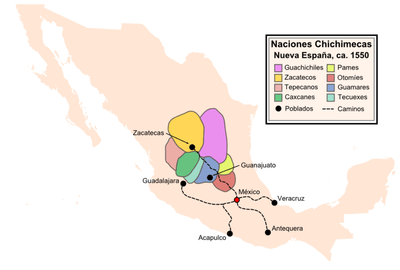Chichimeca
Chichimeca (Spanish: [tʃitʃiˈmeka] (![]()

The Spanish invasion resulted in a "drastic population decline of all the peoples known collectively as Chichimecas, and to the eventual disappearance as peoples of all save the Pames of San Luis Potosí and the related Chichimeca-Jonaz of the Sierra Gorda in eastern Guanajuato."[2] In modern times, only one ethnic group is customarily referred to as Chichimecs, namely the Chichimeca Jonaz, a few thousand of whom live in the state of Guanajuato.
Etymology
The Nahuatl name Chīchīmēcah (plural, pronounced [tʃiːtʃiːˈmeːkaʔ]; singular Chīchīmēcatl) means "inhabitants of Chichiman," Chichiman meaning "area of milk." It is sometimes said to be related to chichi "dog", but the is in chichi are both short while those in Chīchīmēcah are long, which changes the meaning as vowel length is phonemic in Nahuatl.[3]
Ethnohistorical descriptions
In the late sixteenth century, Gonzalo de las Casas wrote about the Chichimec. He had received an encomienda near Durango and fought in the wars against the Chichimec peoples: the Pame, the Guachichile, the Guamari and the Zacateco, who lived in the area known at the time as "La Gran Chichimeca." Las Casas' account was called Report of the Chichimeca and the Justness of the War Against Them. He described the people, providing ethnographic information. He wrote that they only covered their genitalia with clothing; painted their bodies; and ate only game, roots and berries. He mentioned, in order to prove their supposed barbarity, that Chichimec women, having given birth, continued traveling on the same day without stopping to recover.[4]
In the late 16th century, according to the Spanish, the Chichimeca did not worship idols as did many of the surrounding indigenous peoples.[5]
Wars with the Spanish
Chichimeca military strikes against the Spanish included raidings, ambushing critical economic routes, and pillaging. In the long-running Chichimeca War (1550–1590), the Spanish initially attempted to defeat the combined Chichimeca peoples in a war of "fire and blood", but eventually sought peace as they were unable to defeat them. The Chichimeca's small-scale raids proved effective. To end the war, the Spanish adopted a "Purchase for Peace" program by providing foods, tools, livestock, and land to the Chichimecas, sending Spanish to teach them agriculture as a livelihood, and by passively converting them to Catholicism. Within a century, the Chichimeca were assimilated.[6]
References
- Gradie, Charlotte M. "Discovering the Chichimecas" Academy of American Franciscan History, Vol 51, No. 1 (July 1994), p. 68
- The Cambridge History of the Native Peoples of the Americas, Vol. 2: Mesoamerica, Part 2. Cambridge University Press. 2000. pp. 111–113. ISBN 9780521652049.
- See Andrews 2003 (pp.496 and 507), Karttunen 1983 (p.48), and Lockhart 2001 (p.214)
- As cited in Gradie (1994).
- http://www.latinamericanstudies.org/aztecs/Chichimecas.pdf
- Powell, Phillip Wayne (1952), Soldiers, Indians & Silver, Berkeley: U of California Press, pp. 182-199; LatinoLA | Comunidad :: Indigenous Origins
Sources
- Andrews, J. Richard (2003). Introduction to Classical Nahuatl (Revised ed.). Norman: University of Oklahoma Press.
- Gradie, Charlotte M. (1994). "Discovering the Chichimeca". Americas. The Americas, Vol. 51, No. 1. 51 (1): 67–88. doi:10.2307/1008356. JSTOR 1008356.
- Karttunen, Frances (1983). An Analytical Dictionary of Nahuatl. Austin: University of Texas Press.
- Lockhart, James (2001). Nahuatl as Written. Stanford University Press.
- Lumholtz, Carl (1987) [1900]. Unknown Mexico, Explorations in the Sierra Madre and Other Regions, 1890-1898. 2 vols (reprint ed.). New York: Dover Publications.
- Powell, Philip Wayne (1969). Soldiers, Indians, & Silver: The Northward Advance of New Spain, 1550-1600. Berkeley, CA: University of California Press.
- Secretariá de Turismo del Estado de Zacatecas (2005). "Zonas Arqueológicas" (in Spanish).
- Smith, Michael E. (1984). "The Aztlan Migrations of Nahuatl Chronicles: Myth or History?" (PDF online facsimile). Ethnohistory. Columbus, OH: American Society for Ethnohistory. 31 (3): 153–186. doi:10.2307/482619. ISSN 0014-1801. JSTOR 482619. OCLC 145142543.